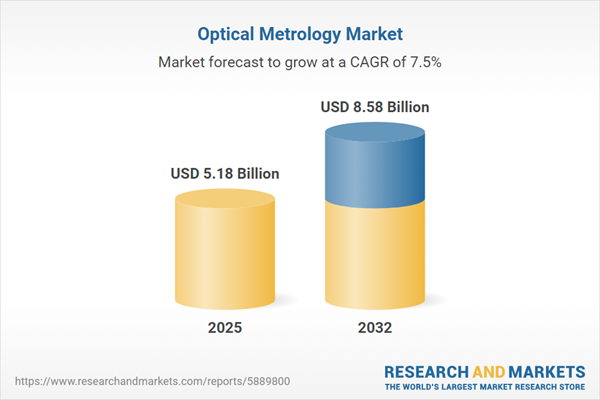Speak directly to the analyst to clarify any post sales queries you may have.
Optical metrology is redefining how global manufacturers and regulators approach quality assurance, enabling more precise, non-contact measurements that drive consistent outcomes and support agile responses to evolving industry requirements. Senior leaders are leveraging these technologies to streamline compliance, strengthen operational agility, and remain competitive in rapidly changing markets.
Optical Metrology Market Snapshot
The global optical metrology market is on a strong growth path, with the market size rising from USD 4.82 billion in 2024 to USD 5.18 billion in 2025 and forecast to reach USD 8.58 billion by 2032. This 7.46% CAGR is propelled by increasing investments in non-contact metrology solutions, as organizations prioritize accuracy and regulation-ready processes. Businesses are adopting robust inspection disciplines to meet tightening standards and anchor their quality management initiatives on advanced, reliable, and consistent measurement technologies.
Scope & Segmentation
This report offers focused segmentation of the optical metrology market to ensure decision-makers can align technology and procurement decisions with operational and compliance objectives across key sectors, technologies, applications, and regions.
- Technology Solutions: Includes confocal microscopy, ellipsometry, laser and white light interferometry, optical profilometry, and advanced spectroscopy. These solutions address the demands for real-time, contactless measurement across manufacturing and research settings.
- End-User Sectors: Covers aerospace, automotive, energy, electronics, healthcare, semiconductors, life sciences, and research organizations. Leaders in these industries rely on metrology for product compliance, safety, and optimized supply chain integrity.
- Product Offerings: Ranges from standalone instruments and platform systems to professional services and analytics tools, providing both high-throughput and tailored configurations for diverse operational needs.
- Application Areas: Encompasses defect detection, in-process inspection, stress and surface layer analysis, and detailed feature mapping, reinforcing quality and precision for regulated product lines.
- Regional Coverage: Spans the Americas, EMEA, and Asia-Pacific, emphasizing technology adoption and incentives in China, Japan, South Korea, and India. Evaluates market entry strategies and local manufacturing priorities for actionable investment planning.
- Key Market Participants: Market innovation is driven by companies such as Keyence Corporation, Hexagon AB, Carl Zeiss AG, Nikon Corporation, Mitutoyo Corporation, Renishaw plc, AMETEK Inc., FARO Technologies Inc., Jenoptik AG, and Bruker Corporation.
Key Takeaways for Senior Decision-Makers
- Integrating artificial intelligence and machine learning within measurement platforms enables automation, giving organizations the flexibility to adapt to new standards and customer requirements.
- Non-contact metrology reduces reliance on manual inspection, allowing faster quality control and paving the way for predictive maintenance.
- Digital twin technology boosts resource allocation and proactive strategy, minimizing operational disruptions in regulated environments.
- Developing agile supply and procurement strategies increases business resilience, maintaining compliance during regulatory or logistical shifts.
- Collaborating with research and academic partners supports early detection of new standards and trends, helping leadership initiate timely operational enhancements.
- Advanced analytics provides in-depth insights for targeted optimization, empowering leadership teams to focus on initiatives with the most strategic value.
Tariff Impact: Navigating New Challenges
Recent tariff changes affecting optical metrology components are prompting companies to adjust procurement models and consider alternate regional operating bases. Relocation toward regions with favorable trade terms, the use of modular equipment, and phased investments are supporting organizational resilience. Ongoing evaluation of supplier ecosystems and monitoring of regulatory developments are becoming central to continuous compliance and efficient business continuity in the face of global trade adjustments.
Methodology & Data Sources
The findings presented in this report result from direct interviews with sector executives and technical specialists. Analytical techniques, including SWOT and PESTLE, were leveraged to ensure the reliability of all insights. Real-world case studies are provided for benchmarking and actionable executive guidance.
Why This Report Matters
- Delivers actionable market intelligence to help leaders adapt to regulatory and technological changes in optical metrology.
- Enables proactive management of supply chain risk and strategic response to global trade and compliance dynamics.
- Offers clear segmentation and regional analysis, supporting sound investment decisions and operational continuity in a competitive environment.
Conclusion
This report equips executives to refine quality management, drive ongoing operational improvement, and maximize returns from optical metrology strategies as business needs and compliance frameworks continue to evolve.
Additional Product Information:
- Purchase of this report includes 1 year online access with quarterly updates.
- This report can be updated on request. Please contact our Customer Experience team using the Ask a Question widget on our website.
Table of Contents
3. Executive Summary
4. Market Overview
7. Cumulative Impact of Artificial Intelligence 2025
Companies Mentioned
The companies profiled in this Optical Metrology market report include:- Keyence Corporation
- Hexagon AB
- Carl Zeiss AG
- Nikon Corporation
- Mitutoyo Corporation
- Renishaw plc
- AMETEK, Inc.
- FARO Technologies, Inc.
- Jenoptik AG
- Bruker Corporation
Table Information
| Report Attribute | Details |
|---|---|
| No. of Pages | 186 |
| Published | October 2025 |
| Forecast Period | 2025 - 2032 |
| Estimated Market Value ( USD | $ 5.18 Billion |
| Forecasted Market Value ( USD | $ 8.58 Billion |
| Compound Annual Growth Rate | 7.4% |
| Regions Covered | Global |
| No. of Companies Mentioned | 11 |









